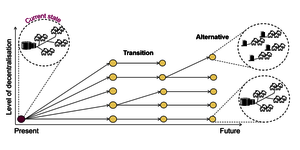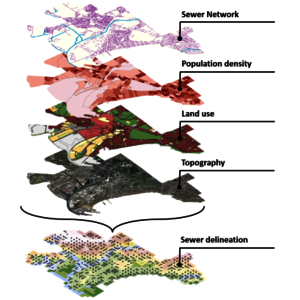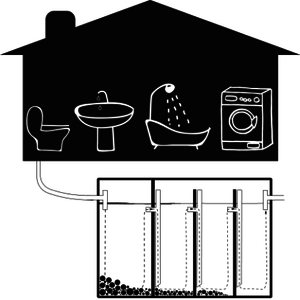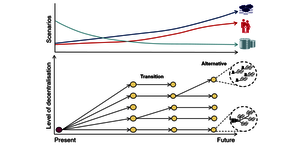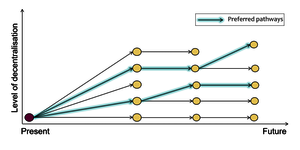Department Urban Water Management
Urban Water Infrastructure Transition Pathways Generator (TPG)
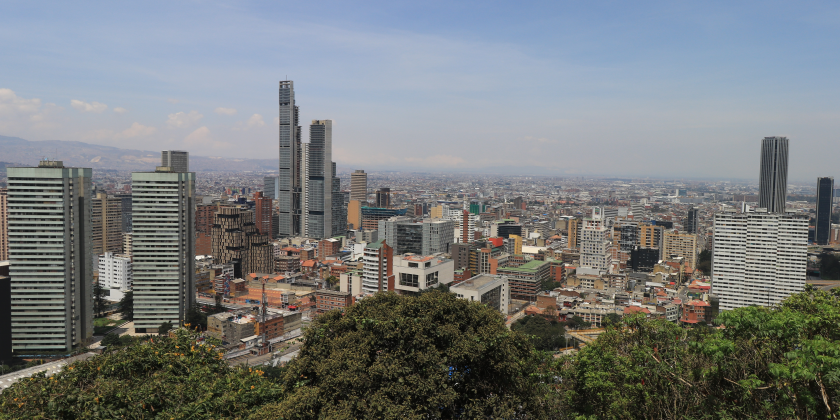
Summary
The ‘Transitions Pathways Generator’ (TPG) model aims at the systematic generation of possible transition pathways describing technical adaptations of the urban drainage infrastructure over time. The adaptation of the infrastructure needs to take into account the existent infrastructure and the required technical and socio-economic aspects to meet future demands. In the past, sewer networks grew with the cities in a centralised way. In OECD countries, centralised urban drainage systems predominate in the cities, with connection rates above 95%. While centralised systems have offer a reliable service for wastewater management, currently aging infrastructure, predicted climatic, demographic, technological, urban and socio-economic developments call for more sustainable, flexible and resilient systems. Decentralised technologies enable a more efficient wastewater management and reduce the requirement for large-scale investments in sewers and centralised wastewater treatment plants. Therefore, this project studies how to transition from the current centralised state of the urban drainage system towards hybrid or decentralised systems.
Project description
This ‘Transitions Pathways Generator’ (TPG) model focuses on foul wastewater sewers, keeping open a later integration with stormwater and/or combined sewers. The TPG will generate numerous transition pathways in a systematic way considering the current state of the urban drainage infrastructure as a starting point. A transition represents a set of required adaptation measures to move from centralised towards hybrid or decentralised systems in consecutive time steps. Each transition leads to a new alternative for the configuration of the system. Each alternative is a specific spatial configuration of the infrastructure (layout and dimension) at a specific point in time. The model should (i) generate simplified sewer networks based on spatial characteristics of the urban environment; (ii) use management strategies to define possible transitions from one state of the system to multiple future alternatives for the system configuration; (iii) evaluate the performance of the transition pathways based on multiple objectives.
Methods
A) Spatial characterisation of the urban drainage infrastructure
The spatial model characterises the urban drainage infrastructure using and abstract representation of the topography, planning rules, demographic and urban characteristics. A coarse-grid is used for the abstraction of the spatial characteristics and the base for the sewer network delineation. The generated drainage infrastructure will be a simplified representation of a real system, with enough information for planning purposes. This method will be used to shape and dimension future configurations of the sewer infrastructure (i.e. alternatives), based on changing spatial characteristics. In comparison with a detailed model, an abstraction of the wastewater drainage infrastructure will reduce the complexity and computational time required for the generation of future alternatives.
The sewer delineation amongst the spatial grid will follow the urban characteristics and the topography assuming a gravity-driven system. Two dimensioning methodologies will be compared to identify which one gets a more accurate representation of the real system in terms of total length of the pipes, diameters frequency distribution, connectivity of the network and required treatment capacity (water consumption). A first approach, will use an adaptation of the Urban Water Infrastructure Model (UWIM) approach proposed by Maurer et al. (2013). UWIM uses the housing density, rain and the catchment area to calculate the length and size distribution of the needed sewer pipes. A second approach, will use an adaptation of the design framework proposed by Duque (2016), using graph theory and dynamic programing to find the cost-optimal hydraulic design of urban drainage systems.
In addition, a descriptive statistical analysis will be done to identify the relevant parameters for dimensioning simplified sewer systems and how do they resemble the real system, regarding the frequency distribution of diameters, number of pipes and network topology. This information will help to describe how the topographic, regulatory, demographic and urban characteristics drive the dimensions of the urban drainage systems.
B) Modelling transition pathways towards decentralised urban drainage infrastructure
i. Integration of decentralised technologies in the simplified representation of the network
The selection of the treatment technologies depends on the required treatment capacity at which the foul sewer system is evaluated. The implementation of such technologies is evaluated at different scales using the spatial representation model. At the block level, decentralised wastewater management technologies such as activated sludge reactors, biogas reactor, anaerobic filter reactors, septic tanks, and local wastewater treatment plants, among others can be applied. The selection of a specific system is based on available space, flow configurations between sources and end uses and required treatment capacity. The last is calculated based on water consumption patterns taking into account the land use classes. Different design criteria help to ensure the proper operation of the system from the technical point of view, allowing a tolerance range using thresholds (e.g. sewer overflows), to identify areas with potential for disconnection.
ii. Transition pathways generation under specific scenarios
The transition pathways generator will systematically define sets (portfolios) of technical adaptation measures that can take place between consecutive time steps considering management strategies and techno-economic constraints. These adaptations will be restricted by, for example: budget, required construction/deconstruction time to change the infrastructure, maximum change in the degree of centralisation or a similarity index among consecutive alternatives. Moreover, the generation of alternatives will follow the set of adaptation measures, the initial state of the urban drainage system and a specific scenario for external factors (e.g. climate change, population development, etc.). The scenarios help us calculate the requirements for the system at each point in time that the alternatives must satisfy. Different extreme scenarios of the external influencing factors will be tested to identify their impact over the generation of the transition pathways. This will help us understand how the transition pathways from existing urban drainage systems towards decentralised or hybrid systems look like for real case studies.
C) Evaluation of transition pathways over time
i. Performance quantification of the transition pathways
Pathways evaluation will consider a set of desirable objectives which depend on the context, and actors (stakeholders) of each case study. Performance Indicators (PIs) will measure how desirable the pathways are, based on the chosen objectives. The PIs represent the attributes for further decision analysis; therefore, they need to be quantifiable. Technical, economic and environmental performance indicators will be defined based on literature review and judgment of decision makers. PIs to measure performance of urban drainage systems can consider structural flexibility of the system, wastewater recovery and reuse, nutrients recovery, energy consumption, among others. The model should be able to support different methods for decision analysis, with different time scales and information about preferences of stakeholders.
Relevance to science and economy
The TPG model will generate possible long-term adaptations over time to reach future demands and requirements of the urban drainage systems (in particular foul sewers) in a systematic and automatic way. It will help to understand how to move from the status quo (centralised drainage systems) towards more sustainable systems with decentralised treatment technologies. The outcome of this project can provide guidance for policy makers by identifying potential ways to adapt urban drainage infrastructure over time, considering population needs and stakeholder’s drivers and preferences. This model will consider technical and economic criteria to generate possible transition pathways towards decentralised urban drainage systems. Policy makers can still evaluate social and environmental aspects by using additional performance indicators during the pathways evaluation.
Publications
Duque, N.; Scholten, L.; Maurer, M. (2024) Exploring transitions of sewer wastewater infrastructure towards decentralisation using the modular model TURN-Sewers, Water Research, 257, 121640 (14 pp.), doi: 10.1016/j.watres.2024.121640, Institutional Repository
Duque, N.; Scholten, L.; Maurer, M. (2024) When does infrastructure hybridisation outperform centralised infrastructure paradigms? – Exploring economic and hydraulic impacts of decentralised urban wastewater system expansion, Water Research, 254, 121327 (13 pp.), doi:10.1016/j.watres.2024.121327, Institutional Repository
Duque Villarreal, N. (2023) Transitions in urban networks: towards decentralised wastewater infrastructure, 161 p, doi:10.3929/ethz-b-000648618, Institutional Repository
Duque, N.; Bach, P. M.; Scholten, L.; Fappiano, F.; Maurer, M. (2022) A simplified sanitary sewer system generator for exploratory modelling at city-scale, Water Research, 209, 117903 (12 pp.), doi: 10.1016/j.watres.2021.117903, Institutional Repository

